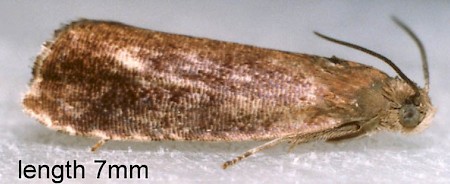Grapholita tenebrosana

49.358 BF1246
Grapholita tenebrosana
Duponchel, [1843]
Wingspan 12 - 14 mm.
This species is widespread in Britain, but not frequently recorded. This may because it does not come readily to light. Records are more easily made by search for larvae in rose hips, and by assembling to pheromone lures intended for G. funebrana, obtainable from Anglian Lepidopterist Supplies
The moths fly at night and in sunshine in June and July, usually high over rose bushes. They can easily be confused with Grapholita funebrana especially as the same pheromone lure attracts both species, sometimes at the same time. They can be separated by the colour of the palps; dull greyish brown in G. funebrana, greyish white on G. tenebrosana. The genitalia of the males are distinct.
The larvae feed in August and September on the hips of Dog rose (Rosa canina), other species of rose and, occasionally, the fruits of rowan (Sorbus aucuparia). The early instar larva eats a small entry hole surrounded by a brown spot, and makes mines under the surface, which are visible as brown lines. Later instars cause the skin of the hip to wrinkle and go deep purple, sometimes with frass extruding through the sides. Larvae are shining pale yellow, tinged red dorsally.
The larva leaves the fruit in October, and overwinters in a spun hibernaculum.
Pupation, in dead wood or under bark, is from April to June.

 UKMoths
UKMoths 



